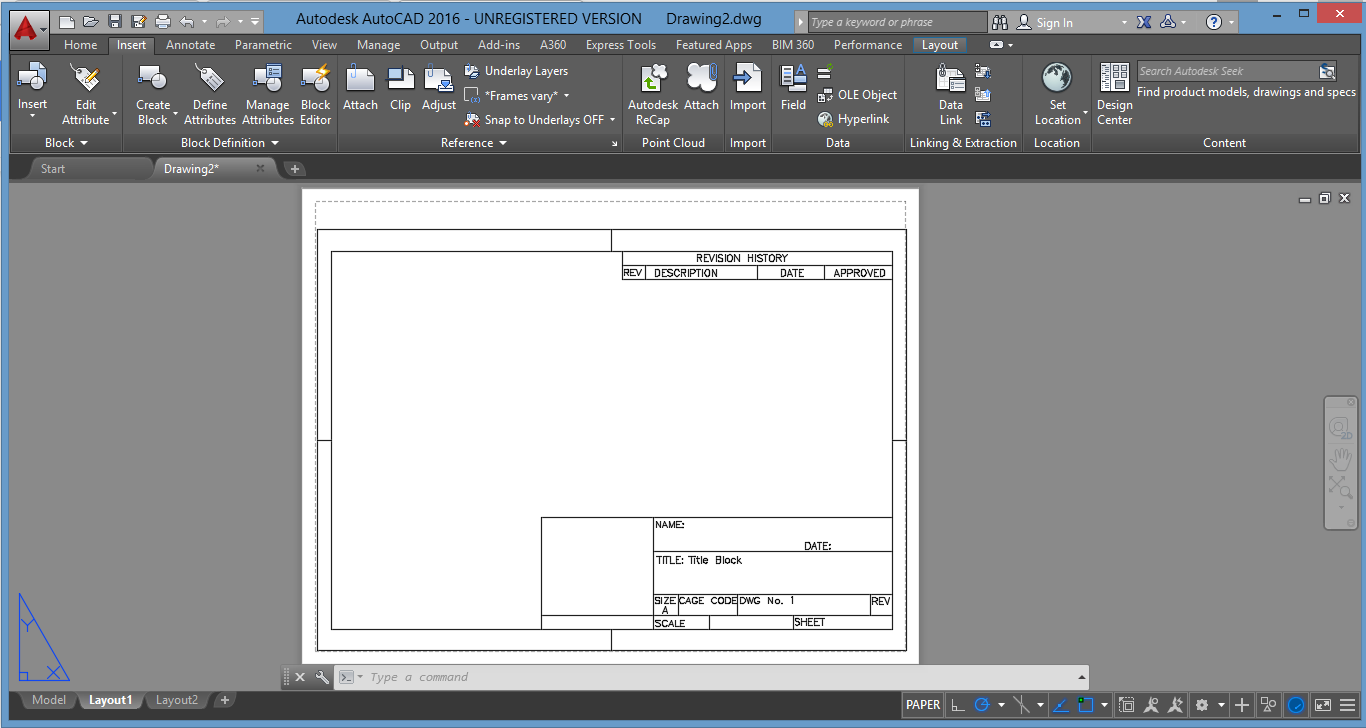
Introduction:
In the dynamic world of Computer-Aided Design (CAD), precision and organization are paramount. Among the foundational elements that contribute to clear and standardized drawings is the title block. A title block not only imparts crucial information about a drawing but also serves as a visual anchor, providing context and professionalism. This extensive guide aims to unravel the intricacies of inserting a title block in AutoCAD, exploring the step-by-step process, customization options, and best practices for creating standardized and professional-looking drawings.
Section 1: Understanding the Role of Title Blocks in AutoCAD
1.1 The Significance of Title Blocks: Title blocks are essential components of technical drawings, containing vital information such as project name, author, date, and scale. They establish a standardized format for presenting drawings, aiding in clarity, communication, and adherence to industry standards.
1.2 Purpose and Components: Delve into the purpose of title blocks and their components. Understand the standard elements found in title blocks, including the drawing title, sheet number, scale, revisions, and company information.
Section 2: Preparing a Title Block Template
2.1 Choosing a Standard: Explore industry standards and company guidelines for title block formats. Understand the importance of consistency in title block layouts to ensure uniformity across drawings and projects.
2.2 Creating a Title Block Template: Learn how to create a title block template in AutoCAD. Understand the use of text, lines, and attributes to design a standardized template that can be easily inserted into multiple drawings.
Section 3: Inserting a Title Block in AutoCAD
3.1 Drawing Setup: Prepare your drawing for the insertion of a title block. Set appropriate units, drawing limits, and scales to ensure consistency with the title block template.
3.2 Inserting the Title Block: Follow a step-by-step guide on how to insert a title block in AutoCAD. Learn the process of using the INSERT command, exploring options for scaling and placement to fit the title block seamlessly onto the drawing sheet.
Section 4: Customizing Title Block Attributes
4.1 Editing Attributes: Understand how to edit attribute values within the title block. Explore the ATTEDIT command and learn how to modify information such as project name, author, and sheet number directly within the drawing.
4.2 Using Data Extraction: Explore advanced techniques for customizing title block attributes using data extraction. Understand how to link attribute values to external data sources, streamlining the process of updating information across multiple drawings.
Section 5: Dynamic Title Blocks in AutoCAD
5.1 Dynamic Blocks Overview: Delve into the concept of dynamic blocks in AutoCAD. Understand how dynamic blocks enhance the functionality of title blocks by allowing users to easily resize, reposition, and manipulate components.
5.2 Creating Dynamic Title Blocks: Learn how to create dynamic title blocks in AutoCAD. Understand the use of dynamic block features such as stretch actions, visibility states, and parameter-driven adjustments to increase flexibility and efficiency.
Section 6: Managing Revisions in Title Blocks
6.1 Revision History: Explore the incorporation of a revision history section within the title block. Understand how to efficiently manage and document changes to the drawing over time, ensuring accurate and up-to-date information.
6.2 Revision Clouds: Learn how to use revision clouds to highlight changes within the drawing. Understand the REVCloud command and how it enhances the visual representation of revisions within the title block.
Section 7: Best Practices for Title Blocks in AutoCAD
7.1 Consistency Across Drawings: Emphasize the importance of maintaining consistency in title block usage across all drawings within a project or organization. Explore strategies for enforcing and adhering to established standards.
7.2 Scalability and Readability: Ensure that title blocks are scalable and maintain readability across different drawing sizes and scales. Explore best practices for designing title blocks that are adaptable to various sheet dimensions.
Section 8: Collaboration and Title Blocks
8.1 External References (Xrefs): Understand how external references (Xrefs) can be used in conjunction with title blocks. Explore techniques for incorporating Xrefs to link title blocks across multiple drawings while maintaining consistency.
8.2 Collaborative Workflows: Explore collaborative workflows involving title blocks in AutoCAD. Learn how to manage title block updates, revisions, and attribute changes in team environments to ensure smooth collaboration.
Section 9: Troubleshooting Title Block Issues
9.1 Attribute Alignment and Visibility: Address common issues related to attribute alignment and visibility within title blocks. Explore troubleshooting tips for resolving misalignments and ensuring all attributes are appropriately visible.
9.2 Scaling Challenges: Explore solutions for scaling challenges when inserting title blocks into drawings of varying sizes. Understand how to maintain the integrity of the title block layout while accommodating different sheet dimensions.
Conclusion:
As we conclude this exhaustive exploration of how to insert a title block in AutoCAD, it is evident that this process is a crucial step toward creating standardized, professional, and organized technical drawings. Whether you are a novice seeking to enhance your drafting skills or a seasoned professional aiming for consistency across projects, mastering the insertion of title blocks unlocks a realm of possibilities. Embrace the precision, customization options, and collaboration potential that title blocks bring to your AutoCAD workflow, and witness how this fundamental element transforms your drawings into clear, communicative, and visually appealing representations. With continuous practice and application, you will navigate the intricate landscape of drafting with confidence, producing drawings that stand as testaments to the power of precision and organization in AutoCAD.